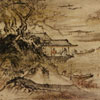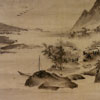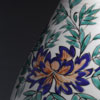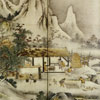The expressionistic effect of the medium, which required facile brushwork and an intuitive approach to the subject, closely reflected the spontaneous nature associated with Zen practice. In Japan, as in China, Zen monasteries became havens for both monks and intellectuals, who created ink paintings of Buddhist and Daoist figures with remarkable subtlety and emotional suggestiveness. By the fifteenth century, skilled artists, trained at temple-based schools, added to the repertoire by depicting imaginary views of China's mountainous landscape and nature studies of birds and flowers. Soon, professional painters fully exploited the medium to create highly decorative folding screens and sliding doors.
During the fifteenth and sixteenth centuries, the Japanese elite developed a taste for imported Chinese porcelain. It was not until the early seventeenth century, however, that immigrant Korean potters discovered-near the town of Arita in Kyushu, Japan's southernmost main island-deposits of clay suitable for firing porcelain. Although most early Japanese porcelain was decorated with cobalt blue, an expensive imported mineral, the prized blue-green of celadon ware also was successfully emulated. In the mid-1640s, the Chinese technique for decorating porcelains in polychrome enamels was introduced in Japan. While many Japanese porcelains in European and American museums were made after about 1650 to 1660 and created for the export market, John C. Weber's collection consists exclusively of early wares intended for use within Japan.






















